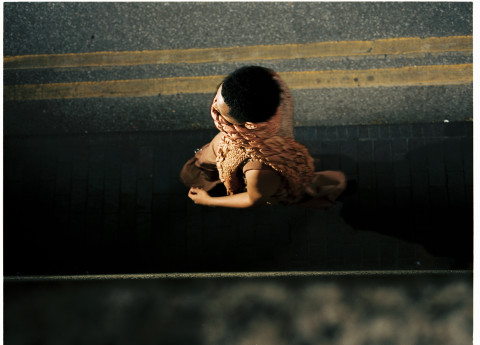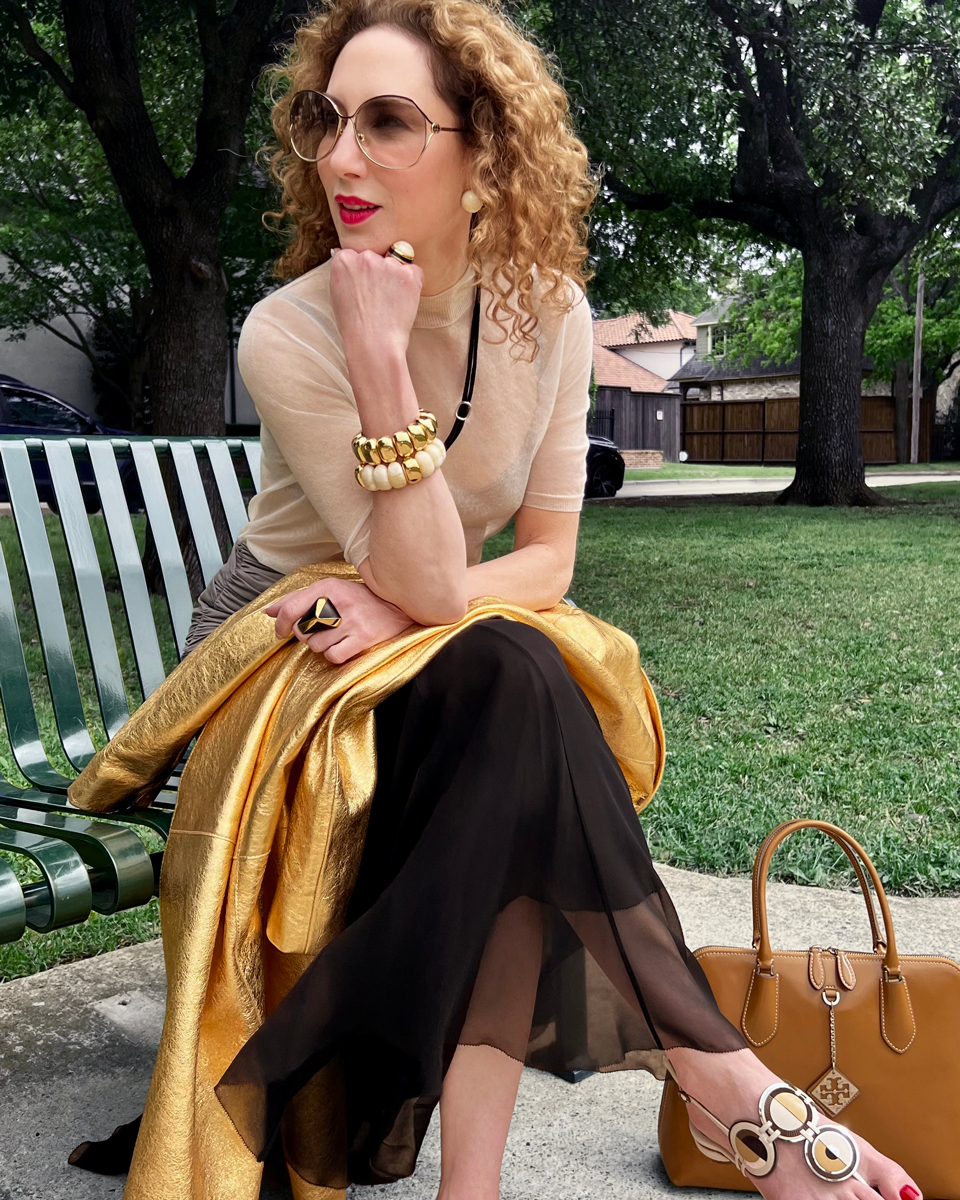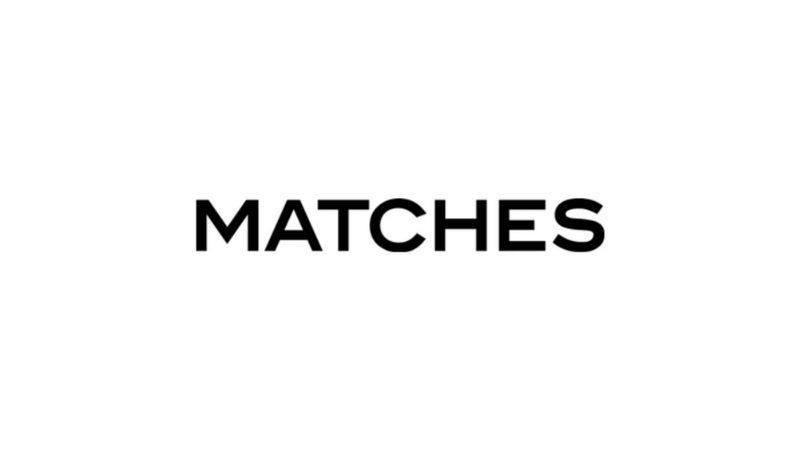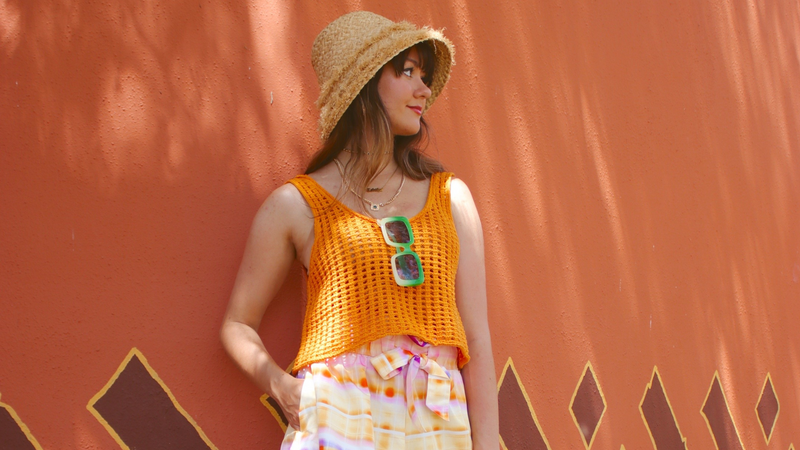New Mythology with Charlie Constantinou
The British-Cypriot designer talks artifacts, adaptation, and clothing for desolate planets.

There’s a popular Cypriot myth that associates the eastern Mediterranean island with Aphrodite, the goddess of love and beauty. Tourists flock to Cyprus for its ancient ruins and connection to Greek lore. Despite centuries of turmoil and changing empires, Cyprus has continued to adapt, transforming as needed in order to prevail. London-born, Cypriot designer Charlie Constantinou is fascinated by adaptation, too. Take his smoke gray FW22 adjustable fit zip trousers. Extra long two-way zippers with O-ring pulls span the length of the pant from hip to ankle, allowing them to be worn five different ways. Adjustable elastics are placed on jacket waists and hoods, even at trouser knees. A tie-dyed, grass green vest shapeshifts with adjustable elements on the shoulders and back. Constantinou’s aesthetic is focused, yet fluid.
In 2022, Constantinou, 24, graduated from Central Saint Martins with an MA in fashion design. Shortly after, he was awarded the prestigious ITS Academy Award for emerging designers, held annually in Trieste, Italy. This year, he was a semifinalist for the LVMH Prize. Just like his nature-inspired color palette, Constantinou’s road to fashion design was organic. “I got to a point where I stopped buying clothes and I started making everything myself, and then making things for friends,” says Constantinou. “I made a portfolio of sketches when I was 18 and I got into a small university and I had to learn everything from scratch. I remember on one of my first days asking how to thread a sewing machine []. But I put in the work and I caught up to my more experienced classmates within a year or two.”Still living in the town he was born in—all of Constantinou’s family lives within 15 to 20 minutes of each other—he’s used to being surrounded by not only the Cypriot diaspora, but myriad other cultures, too. “Cyprus is an island that’s been under so many different empires—it has connections to Egypt and Rome, but also the Middle East and the West into Britain, which I find really interesting,” he says. “Even though we call ourselves Greeks we’re not really Greeks, or even Turkish.”The Charlie Constantinou aesthetic has been described as cyberpunk, crafty couture, sci-fi, and gorp, but none of these labels really do it justice. Delightfully alien and very made-by-hand, the brand is challenging to categorize because Constantinou’s output is tapped into a rare blend of cultures from centuries past future. His use of fabric (all deadstock), dyeing (all original colors), and garment construction (see: quilted nylon), is forward-thinking while his reverence for history comes from a place of curiosity rather than blind nostalgia.From his studio in London, Constantinou offers a glimpse at how he’s creating his own design mythology.


When did you start paying attention to clothing?
I started training in piano and music when I was 11 years old, and up until 18 my plan was to study music composition for film. But when I started working at 16, I got a job at a sneaker store, which led me to streetwear.I started to develop my love for fashion when I discovered Undercover. I never felt represented within the luxury side of the industry, but in the past 10 years we’ve seen younger people taking bigger roles in the industry, even people with a similar background to me. Seeing someone like Nasir [Mazhar] from my own country is a huge reality check that you can actually be in that place as well.
Does your background in music play a role in how you approach design?What fictional worlds inspire you the most?
It plays a big role. Film scores and cinema give you out-of-this-world experiences. I create little research books for each season and there’s always quite a random collection of influences in there. On one page I might have ancient artifacts, followed by a page of manga or video game references. I like trying to mesh otherworldly concepts with lived reality.When it comes to manga, I’m a huge fan of [by Eiichiro Oda]. All the films I grew up watching inspire me, too. Superhero movies. . Desolate planets with extreme weather. I would love to be able to do wardrobe for a film like that, but make everything very wearable at the same time. The outerwear brand Columbia made a Princess Leia–inspired jacket from . Things like that are really interesting to me.

How do you define functionality, and how do you apply this to your designs?You’re building a uniform in a way, without the rigidity traditionally associated with that word.Tell me about the quilted nylon pieces.
It comes down to asking what I want the actual use of a garment to be. Take the adjustable zip trouser, for example. The whole idea is, yes, it looks nice, but you also have a trouser with five different fits in one. The construction of the zippers is designed so that you can wear them differently every single day. It’s also addressing the need to constantly consume. You don’t have to buy multiple new trousers when you have one pair that transforms. We want to allow the person wearing them to customize the fit for themselves. If you can make a piece fully adjustable, it could eventually become a one-size-fits-all garment and then it gets rid of the need to do big batches of grading and size runs, because you can have a single, adaptable thing. Functionality in general comes from the idea that something can have more than just one use.There’s definitely an element of uniformity to it, but we’re breaking away from that idea at the same time. We’re moving away from doing collections in the traditional seasonal way, too. We’re launching the second “season” this summer, but there are many seasonless elements. Being able to constantly adapt to the elements around you is very important.We developed that technique as another way of looking at adaptability. The fabric can expand and grow with the person wearing it. The quilted nylon bag can grow and shrink depending on how much stuff is in it. Taking a synthetic fabric and making it look organic is also really interesting to me. It looks out of nature but the man-made element makes it so durable.

There’s a subtle yet powerful use of pattern and symbolism in your work by way of shapes and spirals. How does mythology play into your design process?
I was always attracted to the mythology element of religion and I was exposed to ancient Greek mythology growing up. There are so many modern things about artifacts, too. I like to look through museum archives like The MET online catalog. There’s jewelry, for example, from the fifth century BC that looks like something a brand would make now. Ancient objects always have an element of future in them which I think is what pulls me towards them. They’re almost more forward-thinking than looking to the past.
All of your clothing is dyed by hand with original colors. How do you develop your dyes?What inspires your unique color palette?
It’s a matter of practice; I’ve been experimenting for years. I first started dyeing because when I was doing my bachelors I got a donation of fabric from a brand, but they sent me a really bright neon green fabric. I wasn’t sure how I could use it so I started dyeing and I realized that I much prefer making my own colors rather than sourcing precolored fabric. I have a base of what colors I work with and how to create them. I try to have very minimal water consumption by using only one vat, and because of that you get really unique variations and natural-looking fades as if the garment has aged over time. The same dye we’ve used for past seasons could take totally differently to a new fabric. All of our fabrics are deadstock, we buy everything in neutral colors like white or beige and then dye them ourselves. No two items are the same.All of our color references come from nature. I consider artifacts to be nature, too. They are objects that have been exposed to thousands of years on the earth. I always build a story of colors that intentionally evolve together with each garment and each collection.

What can you share about Charlie Constantinou season three?Tell me about your 66°North collaboration.Do you work solo or with a team?
We’re carrying over elements from the first two collections, but continuing our research and exploring new worlds. For me, each season is about expanding. References come back from old collections with new meaning. Season three will include womenswear, too.We shot the campaign in February in Iceland. They reached out to me after I finished my MA and asked if I’d like to come to Iceland, and I was like, yeah of course []. It’s the only brand that I’ve come across where they their country. They have this crazy statistic that like 96% of the country owns at least one 66°North garment because the whole company has been built in Iceland from the ground up. They have such a great foundation, and I wanted to have the creative control to bring new things to the table. They let me have a sense of direction and the whole process was very collaborative. Iceland has so many different extreme environments which is a major inspiration for us. We wanted to apply their heritage to our vision.It’s pretty much just me, and then I work directly with my local factory. But since I’m working on season three now and I’m going to take on two interns. I think the biggest struggle for a new brand is actually setting up the business. Once you get past that hurdle it’s about building an infrastructure. We don’t overproduce—when working with stores we ask for minimal numbers for difficult pieces like our knitwear. We make everything locally so that we can manage. I want it to grow organically. We’re not even doing shows. If we had that burden every six months I think it would be so crazy. For me it’s more important if a collection feels finished and I’m happy with it, than to rush it for the sake of doing a showroom. The goal is to look back and feel like past collections are a complete body of work.


 Mother's Day: Carla Rockmore Follows Her Inspiration Though she has 1.3 million followers on Tik-Tok (plus nearly 250K on Instagram and some 72K on Twitter), Carla Rockmore is not your average influencer. The Dallas-based jewelry designer and mother of two is a fashion veteran who mastered the app in the early days of the pandemic when she desperately needed an outlet for creative self-expression. Her styling tutorials, usually filmed in her enviably glorious two-story closet, are joyful, optimistic and addictive to watch. Carla also uses her platform to speak frankly about – and celebrate – her daughter Ivy’s transition.
Mother's Day: Carla Rockmore Follows Her Inspiration Though she has 1.3 million followers on Tik-Tok (plus nearly 250K on Instagram and some 72K on Twitter), Carla Rockmore is not your average influencer. The Dallas-based jewelry designer and mother of two is a fashion veteran who mastered the app in the early days of the pandemic when she desperately needed an outlet for creative self-expression. Her styling tutorials, usually filmed in her enviably glorious two-story closet, are joyful, optimistic and addictive to watch. Carla also uses her platform to speak frankly about – and celebrate – her daughter Ivy’s transition. 

